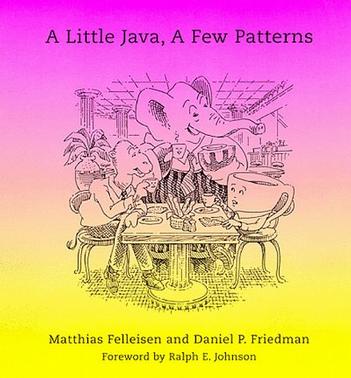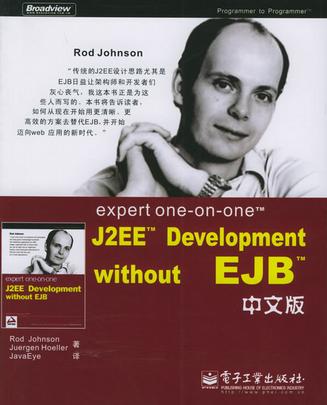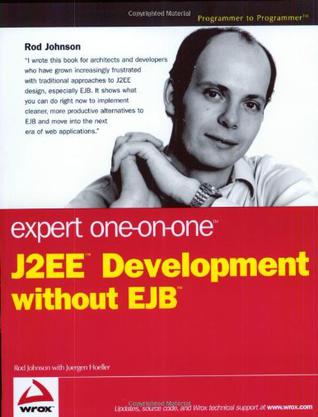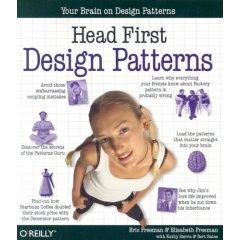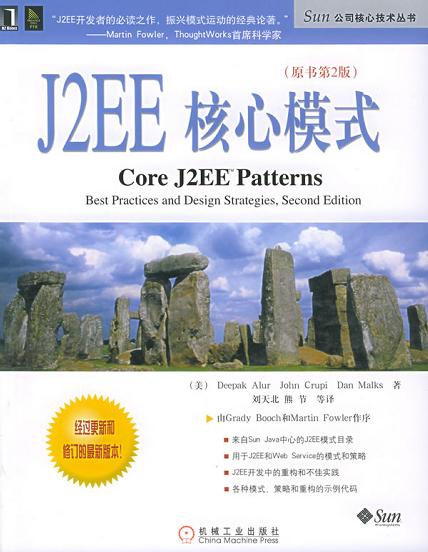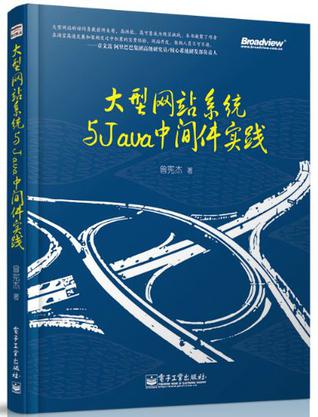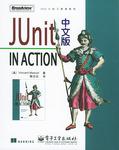欢迎来到相识电子书!
标签:Java
-
A Little Java, A Few Patterns
Java is a new object-oriented programming language that was developed by Sun Microsystems for programming the Internet and intelligent appliances. In a very short time it has become one of the most widely used programming languages for education as well as commercial applications.Design patterns, which have moved object-oriented programming to a new level, provide programmers with a language to communicate with others about their designs. As a result, programs become more readable, more reusable, and more easily extensible.In this book, Matthias Felleisen and Daniel Friedman use a small subset of Java to introduce pattern-directed program design. With their usual clarity and flair, they gently guide readers through the fundamentals of object-oriented programming and pattern-based design. Readers new to programming, as well as those with some background, will enjoy their learning experience as they work their way through Felleisen and Friedman's dialogue. -
A Little Java, A Few Patterns
Java is a new object-oriented programming language that was developed by Sun Microsystems for programming the Internet and intelligent appliances. In a very short time it has become one of the most widely used programming languages for education as well as commercial applications.Design patterns, which have moved object-oriented programming to a new level, provide programmers with a language to communicate with others about their designs. As a result, programs become more readable, more reusable, and more easily extensible.In this book, Matthias Felleisen and Daniel Friedman use a small subset of Java to introduce pattern-directed program design. With their usual clarity and flair, they gently guide readers through the fundamentals of object-oriented programming and pattern-based design. Readers new to programming, as well as those with some background, will enjoy their learning experience as they work their way through Felleisen and Friedman's dialogue. -
J2EE反模式
J2EE反模式,ISBN:9787111177029,作者:(美)达得内(Dudney,B.) 等著,苏金国 等译;苏金国译 -
expert one-on-one J2EE Development without EJB 中文版
乍一看这本书的名字,Expert one on one J2EE development without EJB并没有给人带来太冲击。毕竟关于J2EE的书太多了,而without EJB看上去有点象是故意挑衅EJB的感觉。一本J2EE的书怎么可能会给人带来信念或思维的冲击呢?但是它做到了,它不仅使自己变成了不朽的经典,也使Rod Johnson成为了我最近一年的新偶像。 --xiecc 你的J2EE项目是否耗费了你太多的时间?它们是否难以调试?它们是否效率不彰?也许你还在使用传统的J2EE方案,然而这种主案太过复杂,而且并非真正面向对象。这里的很多问题都与EJB有关:EJB是一种复杂的技术,但它没有兑现自己曾经的承诺。 在这本实战手册中,你将看到另一种截然不同的方案:没有EJB,却可以创建质量更高的应用程序,所需的时间和成本则更低。你将学会如何充分利用各种实用的技巧和工具,包括时下流行的Spring框架和Hibernate两个开源工具。你将看到如何高效地解决企业级应用的核心问题,例如事务管理、持久化、远程调用和web设计。你将了解这种新的方案给可测试性、性能和可伸缩性带来怎样的影响,并亲身体验轻量级架构如何大幅降低项目开发所需的时间和工作量。 自从servlet、EJB、JSP等J2EE技术发布之初,本书作者Rod Johnson就一直在使用这些技术,他对于这些技术的优劣利弊了如指掌。现在,通过这本书,你将可以面对面地分享他的专家经验。 你将从本书学到…… 如何针对自己的应用程序找到最简单、最易维护的架构;在不使用EJB的情况下有效地管理事务;如何利用AOP和loC解决企业级软件开发中的常见问题;web层设计,以web层在设计良好的J2EE应用中的地位;J2EE应用中最有效的数据访问技术,包括JDBC、Hibernate和JDO;如何利用开源产品提升生产率、减少编码量;如何从设计层面上改善性能和可伸缩性。 “传统的J2EE设计思路尤其是EJB日益让架构师和开发者们灰心丧气,我这本书正是为这些人而写的。本书将告诉读者,如何从现在开始用更清晰、更高效的方案去替代EJB,并开始迈向web应用的新时代。” 这本书拥有一大堆“看点”。譬如说,它的作者Rod Johnson拥有10年编写Java程序的经验,目前是Servlet和JDO 2.0两个JSR专家组的成员;再譬如说,书中着力介绍的Spring、Hibernate、WebWork等都是时下流行的开源框架,IoC、AOP之类都是时下流行的概念词汇。而最大的看点就赫然摆在这本书的封面上:“without EJB”。我们曾经在无数的书籍和文章中看到,EJB是J2EE的核心技术之一;而Rod Johnson的这本书竟然宣称,绝大多数的J2EE应用根本不需要EJB。这种近乎挑衅的姿态令任何一个负责的J2EE架构师很难不萌生一探究竟的念头——不论你是打算赞同他还是打算驳斥他。 但所有这些尽皆不是本书最大的价值所在。选择一种架构、一种技术的依据是什么?Rod Johnson认为,应该是基于实践的证据、来自历史项目或亲自试验的经验,而不是任何形式的偶像崇拜或者门户之见。书中谈到了企业应用方方面面的问题和解决办法,而这些方案无一不是这种“循证方法”的产物。除了把这些方案交给读者,Rod Johnson通过这本书希望传达的、更为重要的信息正是“循证”的工作方式——那原本就应该是程序员的工作方式。 -
Java Nio
Many serious Java programmers, especially enterprise Java programmers, consider the new I/O API--called NIO for New Input/Output--the most important feature in the 1.4 version of the Java 2 Standard Edition. The NIO package includes many things that have been missing from previous editions of Java that are critical to writing high-performance, large-scale applications: improvements in the areas of buffer management, scalable network and file I/O, character-set support, and regular expression matching. Most of all, it boosts performance and speed dramatically. Java NIO explores the new I/O capabilities of version 1.4 in detail and shows you how to put these features to work to greatly improve the efficiency of the Java code you write. This compact volume examines the typical challenges that Java programmers face with I/O and shows you how to take advantage of the capabilities of the new I/O features. You?ll learn how to put these tools to work using examples of common, real-world I/O problems and see how the new features have a direct impact on responsiveness, scalability, and reliability. The book includes: * A rundown of the new features in NIO * Basic and advanced I/O Concepts * Binary I/O and the new buffer classes * Memory mapped files and file locking * Character I/O: encoding, decoding and transforming character data * Regular Expressions and the new java.util.regex package * Muliplexing with java.nio Because the NIO APIs supplement the I/O features of version 1.3, rather than replace them, you'll also learn when to use new APIs and when the older 1.3 I/O APIs are better suited to your particular application. Java NIO is for any Java programmer who is interested in learning how to boost I/O performance, but if you're developing applications where performance is critical, such as game computing or large-scale enterprise applications, you'll want to give this book a permanent spot on your bookshelf. With the NIO APIs, Java no longer takes a backseat to any language when it comes to performance. Java NIO will help you realize the benefits of these exciting new features. -
Java Nio
Many serious Java programmers, especially enterprise Java programmers, consider the new I/O API--called NIO for New Input/Output--the most important feature in the 1.4 version of the Java 2 Standard Edition. The NIO package includes many things that have been missing from previous editions of Java that are critical to writing high-performance, large-scale applications: improvements in the areas of buffer management, scalable network and file I/O, character-set support, and regular expression matching. Most of all, it boosts performance and speed dramatically. Java NIO explores the new I/O capabilities of version 1.4 in detail and shows you how to put these features to work to greatly improve the efficiency of the Java code you write. This compact volume examines the typical challenges that Java programmers face with I/O and shows you how to take advantage of the capabilities of the new I/O features. You?ll learn how to put these tools to work using examples of common, real-world I/O problems and see how the new features have a direct impact on responsiveness, scalability, and reliability. The book includes: * A rundown of the new features in NIO * Basic and advanced I/O Concepts * Binary I/O and the new buffer classes * Memory mapped files and file locking * Character I/O: encoding, decoding and transforming character data * Regular Expressions and the new java.util.regex package * Muliplexing with java.nio Because the NIO APIs supplement the I/O features of version 1.3, rather than replace them, you'll also learn when to use new APIs and when the older 1.3 I/O APIs are better suited to your particular application. Java NIO is for any Java programmer who is interested in learning how to boost I/O performance, but if you're developing applications where performance is critical, such as game computing or large-scale enterprise applications, you'll want to give this book a permanent spot on your bookshelf. With the NIO APIs, Java no longer takes a backseat to any language when it comes to performance. Java NIO will help you realize the benefits of these exciting new features. -
Java Nio
Many serious Java programmers, especially enterprise Java programmers, consider the new I/O API--called NIO for New Input/Output--the most important feature in the 1.4 version of the Java 2 Standard Edition. The NIO package includes many things that have been missing from previous editions of Java that are critical to writing high-performance, large-scale applications: improvements in the areas of buffer management, scalable network and file I/O, character-set support, and regular expression matching. Most of all, it boosts performance and speed dramatically. Java NIO explores the new I/O capabilities of version 1.4 in detail and shows you how to put these features to work to greatly improve the efficiency of the Java code you write. This compact volume examines the typical challenges that Java programmers face with I/O and shows you how to take advantage of the capabilities of the new I/O features. You?ll learn how to put these tools to work using examples of common, real-world I/O problems and see how the new features have a direct impact on responsiveness, scalability, and reliability. The book includes: * A rundown of the new features in NIO * Basic and advanced I/O Concepts * Binary I/O and the new buffer classes * Memory mapped files and file locking * Character I/O: encoding, decoding and transforming character data * Regular Expressions and the new java.util.regex package * Muliplexing with java.nio Because the NIO APIs supplement the I/O features of version 1.3, rather than replace them, you'll also learn when to use new APIs and when the older 1.3 I/O APIs are better suited to your particular application. Java NIO is for any Java programmer who is interested in learning how to boost I/O performance, but if you're developing applications where performance is critical, such as game computing or large-scale enterprise applications, you'll want to give this book a permanent spot on your bookshelf. With the NIO APIs, Java no longer takes a backseat to any language when it comes to performance. Java NIO will help you realize the benefits of these exciting new features. -
Beyond Java
Bruce Tate, author of the Jolt Award-winning Better, Faster, Lighter Java has an intriguing notion about the future of Java, and it's causing some agitation among Java developers. Bruce believes Java is abandoning its base, and conditions are ripe for an alternative to emerge. In Beyond Java, Bruce chronicles the rise of the most successful language of all time, and then lays out, in painstaking detail, the compromises the founders had to make to establish success. Then, he describes the characteristics of likely successors to Java. He builds to a rapid and heady climax, presenting alternative languages and frameworks with productivity and innovation unmatched in Java. He closes with an evaluation of the most popular and important programming languages, and their future role in a world beyond Java. If you are agree with the book's premise--that Java's reign is coming to an end--then this book will help you start to build your skills accordingly. You can download some of the frameworks discussed and learn a few new languages. This book will teach you what a new language needs to succeed, so when things do change, you'll be more prepared. And even if you think Java is here to stay, you can use the best techniques from frameworks introduced in this book to improve what you're doing in Java today. -
Expert One-on-One J2EE Development without EJB
What is this book about? "Expert One-on-One J2EE Development without EJB" shows Java developers and architects how to build robust J2EE applications without having to use Enterprise JavaBeans (EJB). This practical, code-intensive guide provides best practices for using simpler and more effective methods and tools, including JavaServer pages, servlets, and lightweight frameworks. What does this book cover? The book begins by examining the limits of EJB technology - what it does well and not so well.Then the authors guide you through alternatives to EJB that you can use to create higher quality applications faster and at lower cost - both agile methods as well as new classes of tools that have evolved over the past few years. They then dive into the details, showing solutions based on the lightweight framework they pioneered on SourceForge - one of the most innovative open source communities. They demonstrate how to leverage practical techniques and tools, including the popular open source Spring Framework and Hibernate.This book also guides you through productive solutions to core problems, such as transaction management, persistence, remoting, and Web tier design. You will examine how these alternatives affect testing, performance, and scalability, and discover how lightweight architectures can slash time and effort on many projects. What will you learn from this book? Here are some details on what you'll find in this book such as: how to find the simplest and most maintainable architecture for your application; effective transaction management without EJB; how to solve common problems in enterprise software development using AOP and Inversion of Control; Web tier design and the place of the Web tier in a well-designed J2EE application; effective data access techniques for J2EE applications with JDBC, Hibernate, and JDO; how to leverage open source products to improve productivity and reduce custom coding; and, how to design for optimal performance and scalability. -
Head First Design Patterns
You're not alone. At any given moment, somewhere in the world someone struggles with the same software design problems you have. You know you don't want to reinvent the wheel (or worse, a flat tire), so you look to Design Patterns--the lessons learned by those who've faced the same problems. With Design Patterns, you get to take advantage of the best practices and experience of others, so that you can spend your time on... something else. Something more challenging. Something more complex. Something more fun. You want to learn about the patterns that matter--why to use them, when to use them, how to use them (and when NOT to use them). But you don't just want to see how patterns look in a book, you want to know how they look "in the wild". In their native environment. In other words, in real world applications. You also want to learn how patterns are used in the Java API, and how to exploit Java's built-in pattern support in your own code. You want to learn the real OO design principles and why everything your boss told you about inheritance might be wrong (and what to do instead). You want to learn how those principles will help the next time you're up a creek without a design paddle pattern. Most importantly, you want to learn the "secret language" of Design Patterns so that you can hold your own with your co-worker (and impress cocktail party guests) when he casually mentions his stunningly clever use of Command, Facade, Proxy, and Factory in between sips of a martini. You'll easily counter with your deep understanding of why Singleton isn't as simple as it sounds, how the Factory is so often misunderstood, or on the real relationship between Decorator, Facade and Adapter. With Head First Design Patterns, you'll avoid the embarrassment of thinking Decorator is something from the "Trading Spaces" show. Best of all, in a way that won't put you to sleep! We think your time is too important (and too short) to spend it struggling with academic texts. If you've read a Head First book, you know what to expect - a visually-rich format designed for the way your brain works. Using the latest research in neurobiology, cognitive science, and learning theory, Head First Design Patterns will load patterns into your brain in a way that sticks. In a way that lets you put them to work immediately. In a way that makes you better at solving software design problems, and better at speaking the language of patterns with others on your team. -
深入浅出Hibernate
本书由互联网上影响广泛的开放文档OpenDoc系列自由文献首份文档“Hibernate开发指南”发展而来。在编写过程中,进行了重新构思与组织,同时对内容的深度与广度进行了重点强化。本书从持久层入手,引出对象/关系数据库映射的由来,接下来聚焦于目前最完善、最强悍的ORM产品——Hibernate。从一个基础程序入手,讲述Hibernate的基本语法与配置,慢慢升高到缓存、延迟加载等高级特性。本书内容深入浅出,先讲述持久层设计与ORM,再由Hibernate概述、Hibernate基础Hibernate高级特性顺序展开,直至Hibernate实战,重点讲述了Hibernate的基础语法、基础配置、O/R映射、数据关联、数据检索、HQL实用技术、自定义持久化实现、Hibernate回调与拦截、Hibernate分页等实用技术,Hibernate实战部分则用一个真实论坛的创建演示了Hibernate的强大功能。本书有丰富的附录部,在附录中讲述了Hibernate常用的映射配置,Hibernate工具、XDoclet模板配置以及Hibernate的益友iBatis用法,还以卡片的形式列出了本书中所用的工具及软件,附录最后一部分是“快速启动代码”,供读者对比与参考,也给初学者提供了一个快带起步的基础。 本书适合于Hibernate的各个阶层的读者。 -
J2EE核心模式
《J2EE核心模式》(原书第2版):“Java领域的版图上撒满了各种类库、工具和技术规范。而缺乏的则是把这些内容融合在一起、解决真实情况下的问题的专业能力。本书中的这些模式,成为了J2EE软件建设过程中的智能水泥。 ——John Vlissides,《设计模式》的作者之一 “《J2EE核心模式》的作者们提取了一组真正实用的模式。他们介绍了应该如何应用这些模式、如何重构你的系统以便从模式中获益。这就像有一个专家组坐在你旁边一样。 ——Grady Booch,Rational软件公司首席科学家 “作者们介绍了大量对于应用架构极有帮助的模式,这是一项了不起的工作。单单是书中的‘重构’部分就值整本书的价钱!” ——Craig McClanahan,Struts首席架构师,JavaServer Faces技术规范组负责人 开发者们常常把“学会一种技术”和“学会使用这种技术进行设计”混为一谈。在本书中,Sun Java中心的资深架构师们分享了他们多年积累的使用J2EE技术进行设计的经验。 本书关注的主要内容,是使用J2EE的核心技术蜒包括JSPTM、Servlet、EJBTM、JMSTMAPI等蜒实现企业应用过程中的模式、最佳实践、设计策略以及经过验证的解决方案。其中的J2EE模式目录包括21个模式以及大量策略,有助于记录、促成运用以上技术的最佳实践。 -
大型网站系统与Java中间件开发实践
本书围绕大型网站和支撑大型网站架构的 Java 中间件的实践展开介绍。从分布式系统的知识切入,让读者对分布式系统有基本的了解;然后介绍大型网站随着数据量、访问量增长而发生的架构变迁;接着讲述构建 Java 中间件的相关知识;之后的几章都是根据笔者的经验来介绍支撑大型网站架构的 Java 中间件系统的设计和实践。希望读者通过本书可以了解大型网站架构变迁过程中的较为通用的问题和解法,并了解构建支撑大型网站的 Java 中间件的实践经验。对于有一定网站开发、设计经验,并想了解大型网站架构和支撑这种架构的系统的开发、测试等的相关工程人员,本书有很大的参考意义;对于没有网站开发设计经验的人员,通过本书也能宏观了解大型网站的架构及相关问题的解决思路和方案。 -
大型网站系统与Java中间件开发实践
本书围绕大型网站和支撑大型网站架构的 Java 中间件的实践展开介绍。从分布式系统的知识切入,让读者对分布式系统有基本的了解;然后介绍大型网站随着数据量、访问量增长而发生的架构变迁;接着讲述构建 Java 中间件的相关知识;之后的几章都是根据笔者的经验来介绍支撑大型网站架构的 Java 中间件系统的设计和实践。希望读者通过本书可以了解大型网站架构变迁过程中的较为通用的问题和解法,并了解构建支撑大型网站的 Java 中间件的实践经验。对于有一定网站开发、设计经验,并想了解大型网站架构和支撑这种架构的系统的开发、测试等的相关工程人员,本书有很大的参考意义;对于没有网站开发设计经验的人员,通过本书也能宏观了解大型网站的架构及相关问题的解决思路和方案。 -
Java
In this completely up-to-date volume, Herb Schildt, the world's leading programming author, shows you everything you need to know to develop, compile, debug, and run Java applications and applets. You'll get complete details on the Java language, its class libraries, and its development environment along with hundreds of examples and expert techniques. -
Effective Java(影印版) (平装)
本书介绍了JAVA编程中的57条极具实用价值的经验规则,这些规则涵盖了大多数开发人员每天所要面临问题的解决方案。通过对JAVA平台设计专家所使用技术的全面描述,提示了在生成清晰、健壮和高效的代码过程中,应该做什么和不应该做什么。 书中的每条规则都以简短、独立的形式出现,包括了详细而精确的建议,以及对JAVA语言中许多细微之处的深入分析,并通过例子代码进一步加以说明。贯穿全书的是通用的语言用法和设计模式,以及一些具有启发意义的技巧和技术。 主要内容包括:1,通行和高效的语言用法,以简明、可读和易于使用的形式介绍专家的建议; 2,有助于你最有效地使用JAVA平台的模式、反模式及习惯用法;3,JAVA语言及其库中通常被误解的细微之处:如何避免这些陷阱和缺陷;4,关注JAVA语言本身及其最基本的库:java.lang、java.util和一个较小的扩展java.io;5,关于序列化的详细介绍,其中包括其他地方没有提及的一些实践建议。 -
Junit in Action 中文版
本书主要介绍了在Java软件开发中使用JUnit进行测试的原则、技巧与实践,深入阐述如何编写自动测试,把一段代码隔离开来测试有什么好处,如何判断何时需要进行整合测试,并对如何测试完整的J2EE应用进行了极具价值的讨论。本书富含开发实践当中的真实案例,以专家手笔讨论了实践中的测试技术,主要内容包括:用mock objects进行隔离测试;用Cactus进行容器内测试;用Ant和Maven进行自动构建;在Eclipse内进行测试;对Java应用程序、Filter、Servlet、EJB、JSP、数据库应用程序、Taglib等进行单元测试。本书适合于在Java平台下进行各类软件开发的开发人员、测试人员、单元测试研习者以及编程爱好者阅读和学习,具有极高的参考价值。 -
现代编译器的Java实现(第2版)
《现代编译器的Java实现》(第2版)可作为高等院校编译技术课程的教材、教师参考书以及编译技术研究人员的参考资料。
热门标签
下载排行榜
- 1 梦的解析:最佳译本
- 2 李鸿章全传
- 3 淡定的智慧
- 4 心理操控术
- 5 哈佛口才课
- 6 俗世奇人
- 7 日瓦戈医生
- 8 笑死你的逻辑学
- 9 历史老师没教过的历史
- 10 1分钟和陌生人成为朋友

